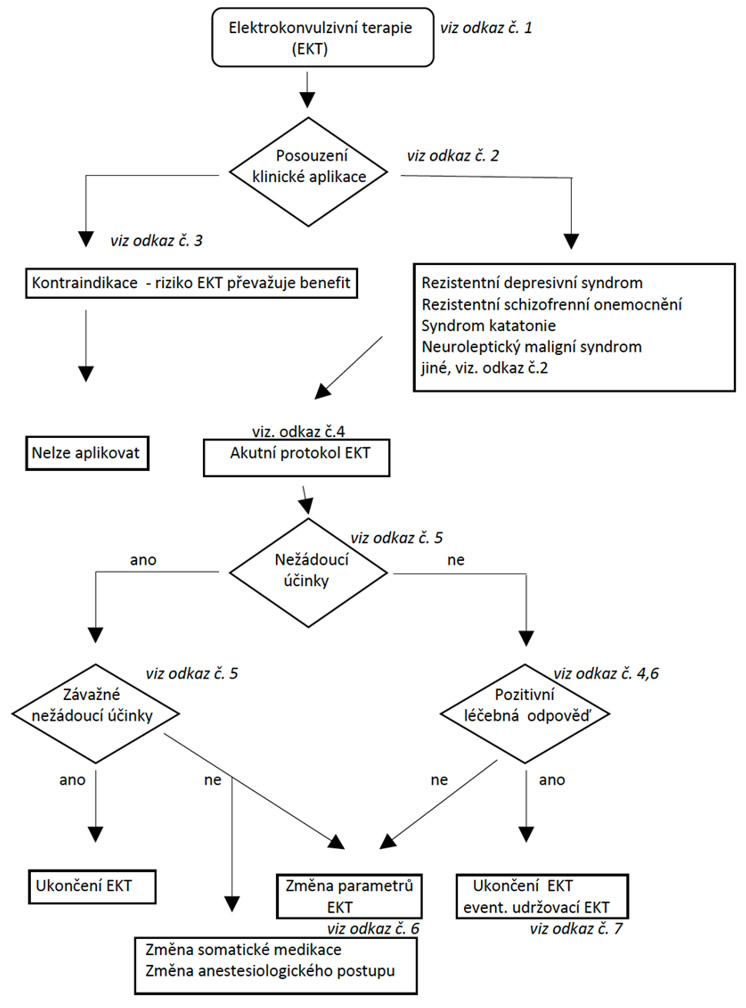Autoři: Buday Jozef, Klírová Monika, Novák Tomáš
Garant: Buday Jozef
Oponent: Kašpárek Tomáš, Ustohal Libor
Vysvětlivky:
ovál - nadpis
kosočtverec - výběr z více variant
přerušovaná čára - diagram pokračuje na další straně
Shrnutí
EKT je důležitou léčebnou modalitou v psychiatrii s vysokou účinností a rychlostí nástupu účinku. I navzdory této dosud nepřekonané účinnosti se však často používá jako metoda poslední volby. Zde je vhodné připomenout, že jedním ze závěrů studie STAR*D bylo, že pokud v léčbě pacientů selhaly dva farmakologické postupy, tak kombinovaná pravděpodobnost dosažení remise a její udržení na dobu 1 roku za pomoci 3. a 4. farmakologické intervence je méně než 5 % (22). Při vhodné indikaci je EKT bezpečnou metodou, která výrazně snižuje riziko suicidality. Udržovací aplikace m-EKT, zejména za ambulantních podmínek, výrazně snižuje riziko rehospitalizace a relapsu depresivní i psychotické symptomatiky.
Literatura
- Abrams R. Stimulus titration and ECT dosing. J ECT. 2002 Mar;18(1):3-9; discussion 14-5. doi: 10.1097/00124509-200203000-00002. PMID: 11925511.
- Adam LA, Crowe RR. Use of ECT in idiopathic intracranial hypertension. J ECT. 2003 Dec;19(4):234-7. doi: 10.1097/00124509-200312000-00011. PMID: 14657778.
- Aloysi, A. S., Bryson, E. O., & Kellner, C. H. (2014). Management of prolonged seizures during electroconvulsive therapy. Indian journal of psychological medicine, 36(2), 220–221.
https://doi.org/10.4103/0253-7176.131012 - Andrade, C., Arumugham, S. S., & Thirthalli, J. (2016). Adverse effects of electroconvulsive therapy. Psychiatric Clinics, 39(3), 513-530.
- Baghai TC, Möller HJ. Electroconvulsive therapy and its different indications. Dialogues Clin Neurosci. 2008;10(1):105-117. doi:10.31887/DCNS.2008.10.1/tcbaghai
- Buday, J., Albrecht, J., Mareš, T., Podgorna, G., Horáčková, K., Kališová, L., ... & Anders, M. (2020). Brain tumors and electroconvulsive therapy: a literature overview of the last 80 years. Frontiers in neurology, 11, 723.
- Dunne, R. A., & McLoughlin, D. M. (2012). Systematic review and meta-analysis of bifrontal electroconvulsive therapy versus bilateral and unilateral electroconvulsive therapy in depression. The World Journal of Biological Psychiatry, 13(4), 248-258.
- Fink, M., Kellner, C. H., & McCall, W. V. (2016). Optimizing ECT technique in treating catatonia. The Journal of ECT, 32(3), 149-150.
- Gómez-Arnau, J., de Arriba-Arnau, A., Correas-Lauffer, J., & Urretavizcaya, M. (2018). Hyperventilation and electroconvulsive therapy: a literature review. General Hospital Psychiatry, 50, 54-62.
- Kerner, N., & Prudic, J. (2014). Current electroconvulsive therapy practice and research in the geriatric population. Neuropsychiatry, 4(1), 33–54. https://doi.org/10.2217/npy.14.3
- Kibret, B., Premaratne, M., Sullivan, C. et al. Electroconvulsive therapy (ECT) during pregnancy: quantifying and assessing the electric field strength inside the foetal brain. Sci Rep 8, 4128 (2018). https://doi.org/10.1038/s41598-018-22528-x
- Kokras N, Politis AM, Zervas IM, Pappa D, Markatou M, Katirtzoglou E, Papadimitriou GN. Cardiac rhythm management devices and electroconvulsive therapy: a critical review apropos of a depressed patient with a pacemaker. J ECT. 2011 Sep;27(3):214-20. doi: 10.1097/YCT.0b013e31820057b3. PMID: 21206373.
- Liu, X., Cui, H., Wei, Q., Wang, Y., Wang, K., Wang, C., Zhu, C., & Xie, X. (2014). Electroconvulsive therapy on severe obsessive-compulsive disorder comorbid depressive symptoms. Psychiatry investigation, 11(2), 210–213. https://doi.org/10.4306/pi.2014.11.2.210
- Loo, C. K., Sainsbury, K., Sheehan, P., & Lyndon, B. (2008). A comparison of RUL ultrabrief pulse (0.3 ms) ECT and standard RUL ECT. The The International Journal of Neuropsychopharmacology, 11(7), 883-890.
- McGirr, A., Berlim, M. T., Bond, D. J., Chan, P. Y., Yatham, L. N., & Lam, R. W. (2017). Adjunctive ketamine in electroconvulsive therapy: updated systematic review and meta-analysis. The British Journal of Psychiatry, 210(6), 403-407.
- Patkar AA, Hill KP, Weinstein SP, Schwartz SL. ECT in the presence of brain tumor and increased intracranial pressure: evaluation and reduction of risk. J ECT. 2000 Jun;16(2):189-97. doi: 10.1097/00124509-200006000-00011. PMID: 10868329.
- Peterchev, A. V., Rosa, M. A., Deng, Z. D., Prudic, J., & Lisanby, S. H. (2010). ECT stimulus parameters: rethinking dosage. The journal of ECT, 26(3), 159.
- Petrides, G., & Fink, M. (1996). The half-age stimulation strategy for ECT dosing. Convulsive therapy, 12(3), 138-146.
- Petrides, G., Tobias, K. G., Kellner, C. H., & Rudorfer, M. V. (2011). Continuation and maintenance electroconvulsive therapy for mood disorders: review of the literature. Neuropsychobiology, 64(3), 129–140. https://doi.org/10.1159/000328943
- Rohland, B. M., Carroll, B. T., & Jacoby, R. G. (1993). ECT in the treatment of the catatonic syndrome. Journal of affective disorders, 29(4), 255-261.
- Rothärmel, M., Quesada, P., Husson, T., Harika-Germaneau, G., Nathou, C., Guehl, J., ... & Moulier, V. (2021). The priming effect of repetitive transcranial magnetic stimulation on clinical response to electroconvulsive therapy in treatment-resistant depression: a randomized, double-blind, sham-controlled study. Psychological medicine, 1-12.
- Sackeim HA. Modern Electroconvulsive Therapy: Vastly Improved yet Greatly Underused. JAMA Psychiatry. 2017 Aug 1;74(8):779-780. doi: 10.1001/jamapsychiatry.2017.1670. PMID: 28658461.
- Weiss, A. (2018). The Electroconvulsive Therapy Workbook: Clinical Applications (1st ed.). Routledge. https://doi.org/10.4324/9781315198897
- Wilkinson, Samuel T. MD; Helgeson, Lars MD; Ostroff, Robert B. MD Electroconvulsive Therapy and Cerebral Aneurysms, Journal of ECT: December 2014 - Volume 30 - Issue 4 - p 47-49 doi: 10.1097/YCT.0000000000000163
Datum zveřejnění: 15.1.2023

